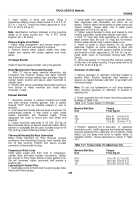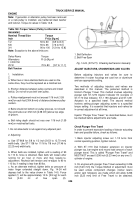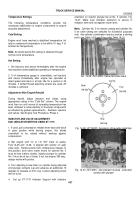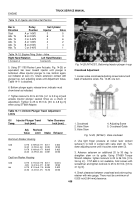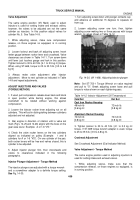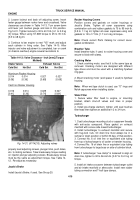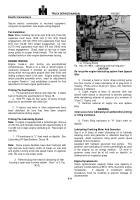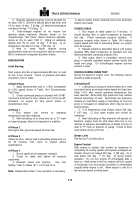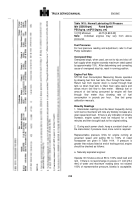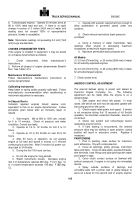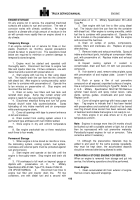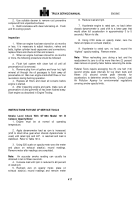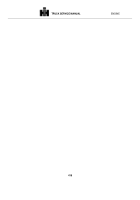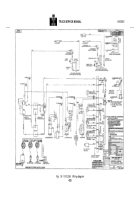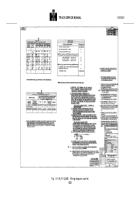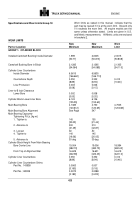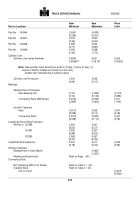TM-5-3805-254-14-P-2 - Page 419 of 894
TRUCK SERVICE MANUAL
ENGINE
b.
Turbocharged engines:
Operate 30 minutes extra at
96 to 100% rated load and rpm.
If there is no rapid
change in excess of 2 inches [50.8 mm] of water and
reading does not exceed 100% of representative
pressure, blowby is acceptable.
Note:
Manometer readings not exceeding 0.3 inch [7.62
mm] surge are desirable.
CHASSIS DYNAMOMETER TESTS
If the engine is installed In equipment, it may be tested
on a chassis dynamometer as follows:
1.
Check
instruments,
follow
manufacturer’s
instructions.
2.
Perform all phases of engine dynamometer BreakIn
Run.
See Table 1414.
Maintenance Of Dynamometer
Follow manufacturer’s maintenance instructions to
service dynamometer.
Calibrating Instruments
Keep beam or spring scales properly calibrated.
Follow
manufacturer’s recommendation when recalibrating or
instrument adjustment is necessary.
In-Chassis Run-In
Inchassis repaired engines should receive runin
equivalent to that on an engine dynamometer.
Follow
procedure given below after an inchassis repair or
rebuild.
1. Start engine.
Idle at 800 to 1000 rpm, noload,
for 5 to 10 minutes.
Check oil pressure and water
circulation. Correct any leaks.
2. Operate at 1/4 to 1/2 throttle for first 5 to 10
hours.
3. Operate at 1/2 to 2/3 throttle for next 45 to 50
hours.
4. After 50 hours of operation, do not operate
engine at full load and speed in excess of 5 minutes
continuously at any time.
After 5 minutes full power run,
drop back to 3/4 throttle.
5. During the first 100 hours’ service:
a. Do not idle engine for long periods.
b. Watch instruments closely.
Decrease engine
rpm if oil temperature reaches 250 deg.
F [121 deg.
C]
or if coolant temperature exceeds 190 deg.
F [88 deg.
C] .
c. Operate with a power requirement low enough to
allow acceleration to governed speed under any
condition.
6. Check exhaust restrictions (back pressure)
as follows:
a. Using a mercury or water manometer, take
readings
when
engine
is
developing
maximum
horsepower at maximum engine speed.
b. Maximum permissible back pressures are:
All Models
(1) 3.0 inch [76 mm] Hg.
or 20 inches [508 mm] of water
for all naturally aspirated engines.
(2) 3.0 inch [76 mm] Hg.
or 25 inches [635 mm] of water
for all turbocharged engines.
7.
Check smoke level,
ANEROID CONTROL ADJUSTMENT
The aneroid bellows spring is preset and sealed at
Cummins Engine Company, Inc.
The following
adjustment can be made while the engine is on a
dynamometer.
1. Start engine and check idle speed.
In most
cases, idle will be low and must be adjusted upward with
fuel pump governor idle screw.
2. Check engine rated power and speed.
If smoke
is not excessive during first 15 seconds of full throttle
operation, but becomes excessive thereafter, aneroid is
not at fault.
3. Check fuel system and turbocharger before
readjusting aneroid control.
4. If hard starting is encountered, the aneroid
pressure valve may be sticking in open position, closed
position will result in excessive smoke.
Replace if
necessary.
PAINT ENGINE
1. Prior to painting, clean surface for maximum
paint adherence.
Dry with compressed air.
2. Cover all openings, pulley grooves, instrument
faces and belts.
Cover all data plates, exposed threads,
wire terminals, hose fittings and pipe openings with water
proof paper or tape.
3. Cover clutch contact surface on flywheel with
antirust compound, if engine is not going into immediate
service.
4. Spray
outside
surfaces
of
castings
and
corrodible parts with a primer coat of yellow lacquer to
serve as a base for the second coat of engine enamel.
415
Back to Top

